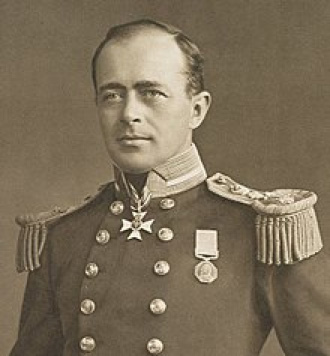British polar explorer Robert Falcon Scott and a team of four reach the South Pole, only to find that Amundsen has beaten them to it. (17th Jan 1912)
On his second Antarctic adventure, Scott led a party of five which reached the South Pole on 17 January 1912, less than five weeks after Roald Amundsen’s Norwegian expedition. On their return journey, Scott’s party discovered plant fossils, proving Antarctica was once forested and joined to other continents. A planned meeting with supporting dog teams from the base camp failed, despite Scott’s written instructions, and at a distance of 150 miles from their base camp and 11 miles from the next depot, Scott and his companions died.
Robert Falcon Scott was born on 6 June 1868 in Devonport. He became a naval cadet at the age of 13 and served on several Royal Navy ships in the 1880s and 1890s. He attracted the notice of the Royal Geographical Society, which appointed him to command the National Antarctic Expedition of 1901-1904. The expedition – which included Ernest Shackleton – reached further south than anyone before them and Scott returned to Britain a national hero. He had caught the exploring bug and began to plan an expedition to be the first to reach the South Pole. He spent years raising funds for the trip.
The whaling ship Terra Nova left Cardiff, Wales in June 1910 and the expedition set off from base the following October, with mechanical sledges, ponies and dogs. However, the sledges and ponies could not cope with the conditions and the expedition carried on without them, through appalling weather and increasingly tough terrain. In mid-December, the dog teams turned back, leaving the rest to face the ascent of the Beardmore Glacier and the polar plateau. By January 1912, only five remained: Scott, Wilson, Oates, Bowers and Evans.
On 17 January, they reached the pole, only to find that a Norwegian party led by Roald Amundsen, had beaten them there. They started the 1,500 km journey back. Evans died in mid-February. By March, Oates was suffering from severe frostbite and, knowing he was holding back his companions, walked out into the freezing conditions never to be seen again. The remaining three men died of starvation and exposure in their tent on 29 March 1912. They were in fact only 20 km from a pre-arranged supply depot.
Eight months later, a search party found the tent, the bodies and Scott’s diary. The bodies were buried under the tent, with a cairn of ice and snow to mark the spot.

